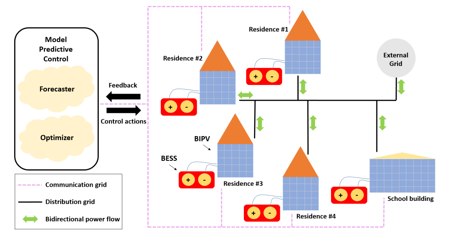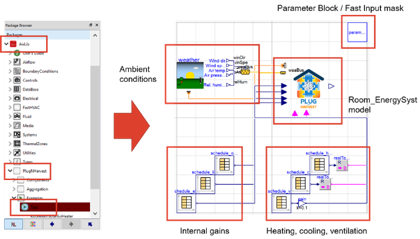In the framework of Plug-n-Harvest activities, CERTH/CPERI developed a Model Predictive Control (MPC)-based strategy for the energy management of a district, whose buildings are equipped with adaptable/dynamic envelopes including Building Integrated Photovoltaic (BIPV) systems and Battery Energy Storage Systems (BESS). The main objective of the proposed MPC strategy lies on the maximization of the district’s autonomy that is achieved through the synergy of the interactive buildings. The proposed control scheme consists of three main components, i.e. the forecaster, the optimizer and the district, which interact periodically with each other.
The forecaster aims at forecasting the values of the stochastic parameters of the model, i.e., the photovoltaic production and the load of each building. The optimizer takes into consideration the real values of the stochastic parameters for the current time step, and the prediction provided by the forecaster for the next time steps, in order to optimally schedule the energy management of the district for the planning horizon. The proposed MPC-based control strategy is applied on a hypothetical 5-node distribution network located in Greece for four representative days of the year, followed by an extensive sensitivity analysis, to demonstrate the effect of seasons and parameters’ modifications on the system behavior.
Furthermore, CERTH/CPERI co-formulated and validated a numerical model representing the dynamic operation of the Plug-n-Harvest Adaptive Dynamic Building Envelope (ADBE) façade, including its individual components, in Modelica. The aim of this model is to energetically investigate four demo sites in different European countries, and estimate their energy demands before and after the installation of the Plug-n-Harvest façade. In order to compare different designs of the façade from an energetic point of view, the building simulations have been conducted by using Modelica. Modelica is an object-oriented language for component-oriented modeling of complex systems and offers the possibility of implementing in-house mathematical functions. This feature substantially enhances the range of applications.
In this project, the standard Modelica library is extended by the AixLib library developed by RWTH Aachen University, which follows the Modelica guidelines, but it can be more applicable to the energy modeling of a building. In AixLib library there are modular blocks that can be connected in parallel or hierarchically to perform a top-level modeling of the entire building, taking into account its structure and the appropriate boundary conditions, such as weather, heating/cooling systems, occupancies and control strategies. For the Plug-n-Harvest project, this ADBE modular toolkit in Modelica includes configurable technical components and passive elements based on real product databases or additional findings from CERTH/CPERI and RWTH Aachen University research efforts. The scope of the simulations is to qualitatively and quantitatively estimate the behavior of the system from an energetic point of view and compare the energetic performance of the buildings under investigation before/after their refurbishment with different hypothetical configurations of the Plug-n-Harvest façade. More specifically, this simulation is expected to provide valuable comparison between the two states of each building, i.e. before and after the implementation of the Plug-n-Harvest solution, in terms of the room temperature level, the room energy demands and the occupants’ comfort.



